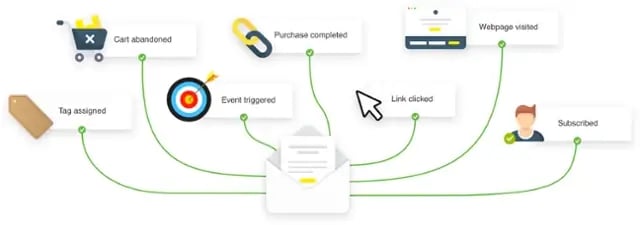Marketing Automation Spotlight: Definition, Benefits, Implementation
Marketing automation has been an indispensable part of the marketing machinery of many companies for years. However, there is still a distorted view of these software solutions. Many business owners see marketing automation as a glorified form of email marketing. Marketing automation tools such as HubSpot, ELOQUA, and Silverpop can do so much more than sending periodic mass emails.
What you can achieve thanks to marketing automation, what exactly the term means, and where marketing automation can be usefully applied are the core topics of this blog post.
Marketing automation explained
Marketing automation is performed by specific software solutions. They automate various marketing activities along the entire customer journey. The linchpin of marketing automation is generated leads. The software analyzes the data generated by each individual lead as well as the interaction of the lead with the company. Based on this, marketing automation supports the selection of the most effective lead nurturing each stage of the customer journey, among other things. When it comes to marketing automation, choosing the right tools is essential in any case. That's why you should choose one of the top MarTech tools or visit events to discover new MarTech trends and tools.
Automated marketing starts with the initial contact between a visitor and the website and continues through to post-purchase support. For example, a customer purchases an e-bike from your online store. Thanks to marketing automation, she immediately receives a personalized message (SMS, mail, etc.) informing her that the order has been received. After delivery, the customer receives another mail with a discount code for a future purchase. On top of that, she is presented with various items that match her new e-bike and/or that she was interested in on your website.
Advantages of automated marketing
In a very rough summary, marketing automation saves you a lot of time and reduces your workload. This in turn has a positive impact on your sales figures and increases the success rate of your marketing department. Your team can reorganize itself as the new software platform takes over secondary tasks for the most part. These include:
- Lead generation, segmentation, and nurturing
- Lead scoring
- Emailing
- Posts on social media
- Publishing and distributing targeted content
- Customer care and retention
The functional scope of any marketing automation software can of course be adapted to the unique needs of the company.

source: getresponse.com
For which companies does marketing automation make sense?
The general answer to this question is quite simple: for all companies - whether B2B or B2C - that want to increase both their competitiveness and the efficiency of their marketing and sales departments. Implementing marketing automation is worthwhile if you have:
- a complex sales process
- many contacts in marketing/sales
- different customer personas
- to address your customers specifically
- a lack of key figures on contemporary marketing options (thus campaign plans are often inaccurate or ineffective)
- a customer base too large or leads too numerous to nurture them personally
- to persuade more visitors at the beginning of the customer journey
- to use more of today's email marketing opportunities
- room for improvement with your email marketing (lower cost, increase impact)
- Manual marketing campaigns that do not achieve the desired results and/or are too time-consuming.
- no capacity to respond to real-time triggers.
Areas of application for marketing automation
Marketing automation software can be used in a variety of ways. For example, you can plan, control and evaluate campaigns multi-stage, cross-media and target group-specific. Marketing automation also completes repetitive tasks such as sending newsletters, personal greeting cards and offer letters and collects and maintains relevant data from potential and existing customers. Another considerable possibility lies in leads. The software can help you to:
- Generate leads, for example with a call-to-action, directed to the landing page with detailed information, offers, freebies, etc.
- Segment leads - marketing automation sorts generated leads based on criteria such as demographics, interaction with your website, readiness to buy, and downloaded content.
- Nurture leads, for example with targeted, personalized email marketing.
- Evaluate leads by classifying generated leads according to buying behavior or use of your website. This allows you to qualify further maintenance measures for your marketing and/or sales teams.
Implementing successful marketing automation
Before you implement marketing automation you should follow these six steps.
- Define your sales process and highlight how leads become customers. The sales process determines the use of marketing automation. For example, businesses with a multi-layered sales cycle benefit the most because many components can be automated. But marketing automation of individual workflows - like sending a reminder email when goods are left in the shopping cart - also reduces workload and leads to more sales for any business.
- Get to know your customers. You should know who your customers are and what they expect from your company. That is the only way to best align marketing automation with how customers interact within the customer journey.
- Find out which steps your customers want to take during the customer journey. That helps you target your marketing automation strategies and drive the sales process.
- Create all necessary content in advance. Whether email, newsletters, blog posts, social media posts, videos, or e-books, any content needed in your marketing automation must be in place before implementation. This is where the holistic MS Office Add-In Suite from empower® comes in! The add-in provides your entire company with a central library for templates and documents, enables central email signature management, and many other options that go hand in hand with optimal marketing automation.
- Ensure communication within your organization. For your marketing automation to generate maximum impact, cross-departmental and ongoing communication between sales, marketing, and customer support is essential.
- Test and analyze your marketing strategy. That determines whether marketing automation is working at the right interfaces in the customer journey. Look at the click and conversion rates, key figures, the time a user spends on your website, bounce rates, etc.
Most companies today need marketing automation. Marketing automation creates a lot of free capacity within your team. These software solutions also enable individualized, targeted, and real-time marketing strategies and higher sales figures.
Our empower® Suite simplifies the necessary content creation and management for successful marketing automation. If you have any questions, please contact us for a free consultation.
You May Also Like
Related articles

Document automation - how your work takes care of itself

6 must-knows about AI and document automation

